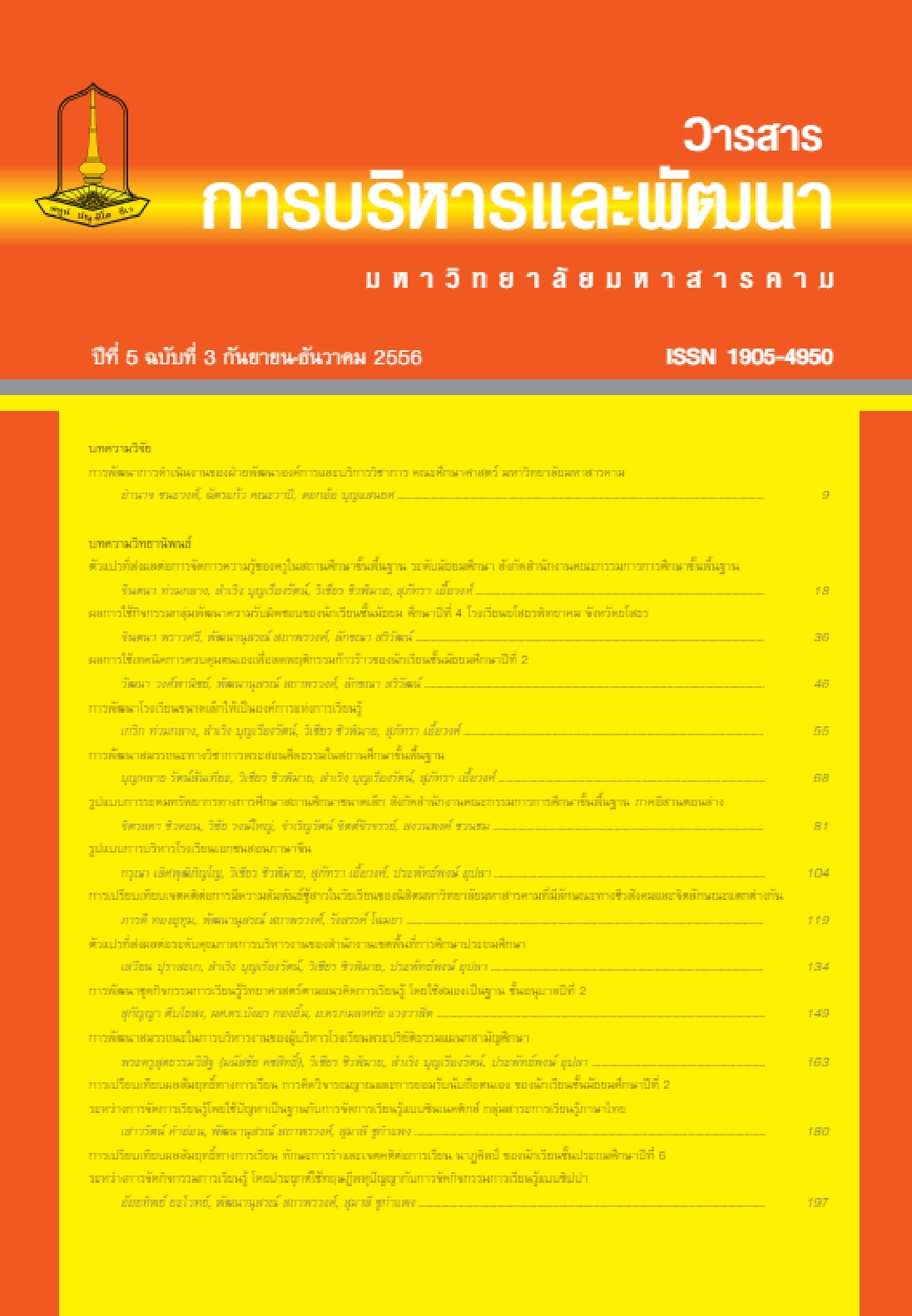Comparisons of Learning Achievement, Critical Thinking and Self-Esteem of Matthayomsueksa 2 Students who Learned Using Problem- Based Learning Approach and Synectics Learning Approach for Thai Language Content Strands
Main Article Content
Abstract
The purposes of this study were (1) to develop the plans for organization of learning based on the Problem Based Learning and using the Synectics learning approach with a required efficiency of 80/80, (2) to find out effectiveness indices of these two developed learning plans, (3) to compare critical thinking and self-esteem of Matthayomsueksa 2 students between before and after using of the two mentioned approaches, and (4) to compare learning achievement, critical thinking, and self-esteem of the students who learned using different learning approaches. The sample used in this study consisted of 61 Matthayomsueksa 2 students attending Potisanvitthaya school in Kusuman District, under the Office of Secondary Educational Service Area Zone 23 in the second semester of the academic year of 2011, obtained using the cluster random sampling technique. They were randomly divided into two experimental groups, 28 and 33 students, in which the classroom group 2/2 used the organization based on the Problem Based Learning approach and group 2/3 used Synectics learning approach. The instruments used for the study comprised of 2 types of learning plans as mentioned 9 plans each, for 2 hours per plan ; and 3 types of the instruments used for collecting data comprised of a 40-item of learning achievement test with discriminating powers ranging 0.26 -0.61 and a reliability of 0.84 ; 25-item analytical thinking ability test with difficulties ranging 0.45- 0.59 , discriminating powers ranging 0.34- 0.77, and a reliability of 0.77 ; a 20-item scales of selfesteem with discriminating powers ranging 0.30-0.58, and a reliability of 0.82. The statistics used for analyzing data were mean, standard deviation, percentage, t-test (Dependent Sample) and F-test (One-way MANOVA) were employed for testing hypothesis.
The results of the study were as follows:1. The Problem based learning and Synectics learning approach had efficiencies (E1/E2) of 82.95/80.36 and 83.66/81.06 respectively.
2. The Problem based learning and Synectics learning approach had the effectiveness indices of .5933 and .6112, indicating that these students progressed their learning at 59.33 and 61.12 percentage respectively.
3. The students who learned using Problem based learning and Synectics learning approach showed gains in critical thinking ability and self-esteem from before learning (p< .05).
4. The students who learned using Synectics learning approach showed higher learning achievement, critical thinking abilities, and self-esteem than who learned using Problem based learning at the level of significance .017.
Downloads
Article Details
References
Academic and Educational Standards Office. (2008). Indicators and Core Learning Theme, Content Strands of Thai Language, According to Basic Education Curriculum B.E2551. Bangkok: Ladprao Publishing of Teachers’ Council.
Gordon, William J.J. (1972) The Metaphorical Way of Learning and Knowing Synaptic Education Press. Cambridge: Leaning.
Joyce, Bruce ; Weil, Marsha ; Calhoun, Emily. (2011). Models of Teaching. 8thed. Boston: Pearson Education, Inc.
Kritsana Sinlapanoraset. (2010). Developing Creative Writing Ability of Prathomsueksa 6 Students Between Organization of Learning Activities Using Synnetics Model and Using Mind Mapping Model. Thesis for Master of Education Degree. Mahasarakham: Mahasarakham University.
Lemlech, Johanna Kasin. (2004). Teaching in Elementary and Secondary Classrooms: Building A Learning Community. New Jersey: Pearson Education, Inc.
Ministry of Education. (2008). The Core Curriculum of Basic Education, B.E.2551. Bangkok: The Agricultural Co-operation of Thailand Publishing.
Naruemon Ngoyphala. (2011). Comparisons of Reading for Main Idea, Analytical Thinking, and Learning Responsibility of Prathomsueksa 6 Students between Organization of KWL-Plus and Problem-Based Learning . Thesis for Master of Education Degree. Mahasarakham: Mahasarakham University.
Nirat Jantharajit. (2010). Learning For Thinking. Maha Sarakham: Maha Sarakham University Publishing.
Puangrat Boonyanurak. (2001). “ Is The Nursing Management Important?” Journal of The Faculty of Nursing. Burapa University (9) 2 ; (May – August): 49 – 59.
Santrock, John W. (2008). Educational Psychology. 3rd New York: McGraw-Hill.
Somjit Srisuk. (2007). The Development of Creative Writing Ability of Prathosuksa 6 Level By Using Synectics Learning Approach. Thesis for M.Ed. Nakhon Ratchasima: Nakhorn Ratchasima Rajabhat University.
Sumran Boontham. (2007). Comparisons of Outcomes of Creative Writing Learning in Thai Language Learning Strand of Prathomsueksa 5 Students Between Organization of Problem-Based Learning and 4 MAT Learning. Thesis for Master of Education DegreeMahasarakham: Mahasarakham University.
The National Basic Educational Testing Office. (2010) The Report of Analysis on the Results of Testing and Quality Evaluation, Academic Year of 2553. Bangkok: The National Basic Educational Testing Office.
Tissana Khammanee. (2005). Teaching Strategies: Knowledge for Effective Learning Process. 4th edition. Bangkok: Chulalongkorn University Publishing.
Tissana Khammanee. (2010).. Teaching Strategies: Knowledge for Effective Learning Process. 13th edition, Bangkok: Dhan Suttha Publishing.


